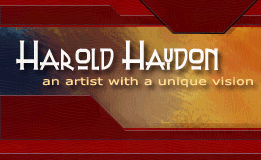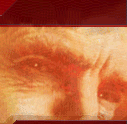Harold Haydon was moving from philosopher
to artist in 1931. As he would comment later:
"Serious study of drawing and painting began
rather late in my education, after receiving the degree of MA in Philosophy in
1931. At this time I determined
that the artist and philosopher were parallel in their approach to life, differing
principally in their media of expression. Feeling greater attraction to the manipulation
of objective materials than of verbal and logical symbols for the sake of expression,
I began study during 1931-32 in the Evening School of the Art Institute of Chicago.
My philosophic interests concentrated largely in the field of aesthetics and
I took occasion to construct an intellectual background for professional work
in art."
And so, while continuing with post-graduate study in aesthetics at the University
of Chicago during the academic year of 1931-32, Haydon refined his binocular
vision theory, absorbed as much as he could from traditional art training,
and began sharing his ideas with others. Again, in reference to this transitional
time he wrote: "a philosopher deals in abstractions. But an artist must
get out and deal with the world directly."25 Risky enough for most artists,
but to be a proponent of a radical and innovative approach to art takes a degree
of self assurance beyond the norm.
The next year, Haydon continued his practical training by adding day classes,
as he describes:
"The following year, 1932-33, I entered
the School of the Art Institute as a special student, selecting courses in the
Upper School most suitable for
rapid development. I continued Life Drawing, begun in the Evening School, under
Edmund Giesbert; studied Still Life Painting with Frederick Poole, Figure Painting
with Louis Ritman, and Lithography. In addition I undertook the study of anatomy,
continued etching and the making of block prints, while endeavoring, mainly through
reading, to acquaint myself with the tradition of painting. This year of concentrated
effort led to no degree but only to honorable mentions."
Beyond
the courses Haydon mentioned, his academic record from the School shows that
he took Research
from Wilkins, Lettering from Lloyd Cowan, his lithography
class was with David McCosh, and that he was attending Helen Gardner's art
history lectures in addition to his own reading.
His paintings during this time incorporate the range of his activities and
interests. Some are clearly studio class assignments, the still lifes and figure
studies, others are paintings from nature done during the summers in Ontario
at Camp Ahmek where he was a camp counselor, and then there are his continuing
developments of the binocular vision style. An example of one of his more interesting
figure studies is an untitled work from 1933
(oil on canvas, 37 1/4 x 35 1/2" PA0385).
There are two versions of this painting, using the same model only posed differently.
In the background are the usual partitions and drapery used in studio backdrops,
the model has very casually and even dramatically draped herself on a wooden
chair, her coat falling off her right shoulder, her scarf and suit jacket askew,
and she gives us, or rather Haydon who is painting her, a very hard and penetrating
stare out the corner of her eye. For his part, Haydon has amplified her angular
features, elongated her neck and given her a left hand that could be right
out of an El Greco painting.
Haydon's studies from nature benefited well from his year at the Art Institute.
Those from the summer of 1933 when he was a counselor at Camp Ahmek in Ontario,
show substantial improvement as his style became more unified and confident.
Many are scenes within the forest, looking into a thicket of trees, the living
ones intermingled with dead and fallen trunks, stumps and undergrowth, as for
example in this untitled forest scene. (1933,
oil on fiberboard, 10 x 14",
PA0305) Haydon would continue painting these souvenir
pictures, as he called them, from his summer trips, whether to Canada or to
Vermont where he would
later be spending his summers. They are almost always in this same quick, freely
painted style and are usually small in scale, ranging from his "thumbnail" sketches
done on card stock cut to approximately 4 x 6" up to a 16 x 20" size
of cut masonite or stretched canvas.
In addition to paintings for his studio course work and his nature studies,
Haydon was also continuing to work in his binocular vision style, as seen in
Reflection, (1933, oil on canvas, 31 x 27" PA0421).
The painting shows Haydon's image reflected in a hanging mirror. Behind the
mirror are the painting
studio sky lights in the upper left corner and surrounding the mirror are the
studio's ceiling and adjacent walls. Every object, most clearly the mirror,
is seen in the doubled vision manner, except Haydon's reflection, which of
course is his point of focus. He entered this painting into a student art exhibition,
and it was at this time, as referred to at the beginning of this essay, when
he feared other students would steal his discovery from him. How the painting
was actually received and whether it was understood or appreciated in any way
by his teachers or fellow students is not known. All that is known is that
no one "stole" the idea or chose to follow his lead.
Added to his studies Haydon became involved in a very interesting project where
he produced decorative lettering, pictographs and illustrations for a publication
about the Chicago Worlds Fair. Youth Inspects the New World At A Century of
Progress Exposition first appeared in July 1933 as an Introduction for
YMCA youth to the Century of Progress World's Fair Exposition that
Chicago was hosting. The 64-page booklet described general areas of the Fair
and gave an overview
of the progress made in each area during the last 100 years. Charles E. Hendry
of George Williams College wrote the text, and Haydon made the drawings, pictographs
and decorative layout elements. He had been publishing drawings and cartoons
during his high school and college years in various student publications, but
Haydon needed some more practical training to complete this first professional
assignment. To prepare for the work, Haydon took a lettering class earlier
that year during the 1932-33 Winter term at the School of the Art Institute.
Although he didn't finish the class, he was probably the only student of the
time to have his work published.
|



